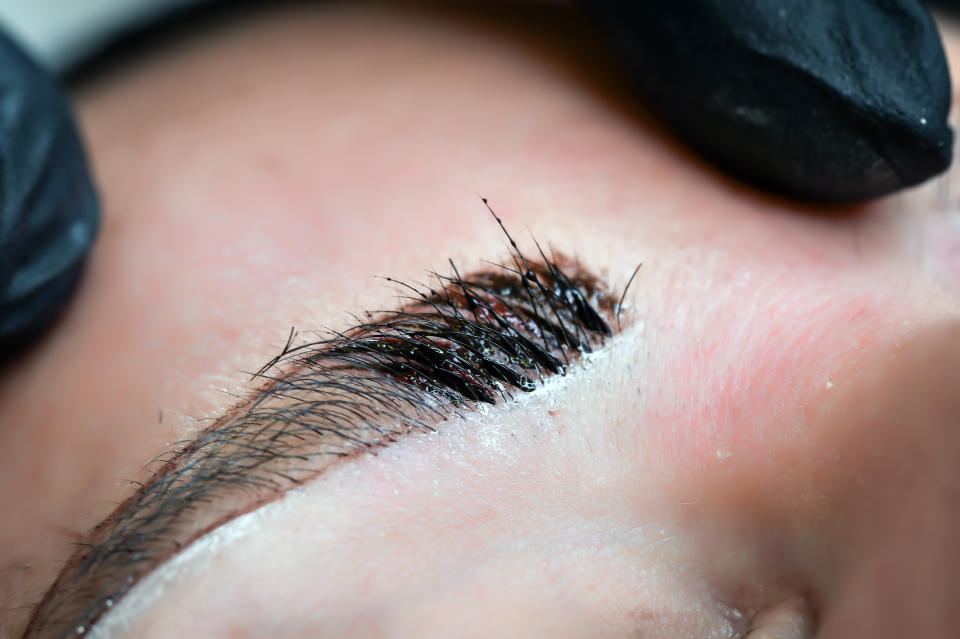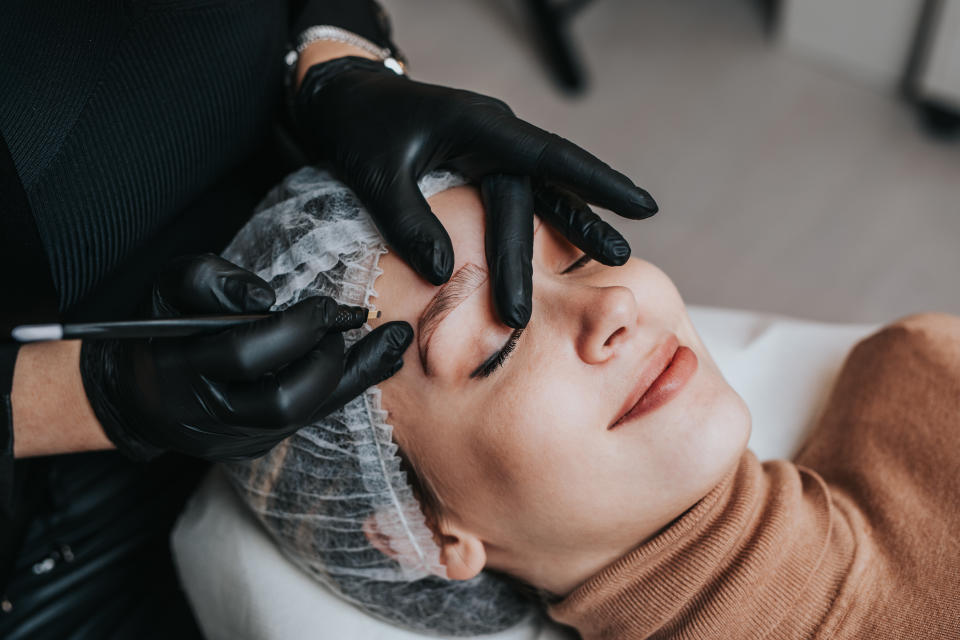What Is Microblading and Is It Right for Your Brows?
Thin eyebrows are an issue for a lot of us. Whether you over-plucked your brows in your youth or you’ve lost thickness due to aging or menopause, you might think that all you can do now is draw them on. But while that may have been true twenty years ago, today’s beauty tool kit has a lot more options. One of them is microblading, a technique that makes it look like the toll time and tweezers took never happened. So, what is this magical beauty treatment that creates the appearance of a full, natural-looking brow? (And is it right for you?) Read on for answers.
What is microblading?

Microblading is a semi-permanent makeup procedure and form of cosmetic tattooing. However, unlike traditional tattoos, which require a tattoo gun and have a lengthy healing process, microblading technicians use a blade-shaped tool with a row of barely-there needles to deposit pigment in the shape of hair-like strokes along the brow. The result of this eyebrow tattoo process? Unbelievably realistic-looking brow hairs that last for a year or more.
Is microblading a tattoo?
Technically speaking, microblading is a form of semi-permanent tattoo, but it’s not permanent like a true tattoo. You see, microblading sits in the epidermis layers, which shed naturally over time. This is why the work done by microblading incisions fades after a year or two. Traditional tattoos, on the other hand, result from concentrated tattoo ink that penetrates the skin’s surface, giving them an opaque and permanent result.
What’s microshading?
The names may sound similar, but microblading and microshading (also known as “powder brows”) are two different things. Compared to microblading’s super precise, individual hair look, microshading offers a much softer finish that aligns to your eyebrow shape. Think of it like using a soft brow pencil as opposed to a thick brow pomade. In addition, where microblading tattoos tiny, hair-like strokes in your existing brows, microshading tattoos pin-like dots along the brows for a less defined finish that mimics natural hair.
What are the benefits of microblading?
There are several benefits of eyebrow microblading — here are a few.
It provides long-lasting results.
This non-invasive treatment yields flawless brows for a year or longer. This means that you won’t have to mess with brow gel, as microbladed brows retain their shape and size without maintenance.
You’ll spend less time getting ready in the morning.
How long does it take you to “put on your face” each day? Now, how many of those minutes are allocated to penciling in your brows? If it’s more than a minute, microblading might be for you. Since the treatment is semi-permanent, you won’t need to waste time filling in your sparse brows in the morning.
It doesn’t smudge or smear off.
With microblading, you don’t have to worry about smudges or smears. You can sweat, shower, and swim without the fear of pigment dripping down your face.
It makes you look younger.
It’s no secret that hair tends to thin and become more sparse as we age. Microblading corrects for this, turning back the hands of time by creating a fuller, more symmetric look. Plus, microblading pigments are formulated for color fastness, which is especially important for anyone going gray.
It saves money in the long run.
Consider how much money you spend on eyebrow waxing, brow pencils, brushes, and tweezing. Add it all up, and you’ll likely see that value in microblading as an investment that saves money over time.
It’s an easy way to rejuvenate the eyebrows.
Whether due to aging, illness, or overtreatment, it’s not uncommon to experience hair loss in the brow area. Microblading provides a natural-looking solution that can bolster your confidence and help you put your best face forward.
What does the microblading process look like?

During a microblading session, a brow technician will map out your eyebrows with threads marked in ink. This allows them to clearly see the shape of your eyebrows and identify areas that need filling in. A numbing cream is then applied to the area, and the needling process begins. Your technician will gently implant pigment via featherweight strokes. If any discomfort is experienced at this stage, the technician will add another layer of numbing cream before continuing. A final layer of pigment is then added over the initial strokes to create the finished look.
Is microblading safe?
In the hands of an experienced brow technician, the microblading process is safe and relatively pain-free. That said, there is a small risk of infection if the area isn’t properly sanitized before the procedure. And since you’re introducing a synthetic substance to your skin, it could react by forming tiny bumps called granulomas. Other possible side effects include:
Keloids
Allergic reaction to the ink
Sarcoidosis
Scabbing around your natural brows
Note: If you have safety concerns around microblading and/or a specific medical condition, contact your healthcare provider before undertaking the process. An experienced brow technician can also provide insight into whether or not microblading is a good option for you.
Is there anyone that should avoid microblading?
Most brow techs won’t microblade pregnant or breastfeeding women to avoid risk of infection. If you’ve recently given birth, speak to your healthcare provider before microblading, wait at least eight weeks before treatment, and stop breastfeeding before booking your appointment. In addition to pregnant or lactating women, microblading is not suitable for:
anyone under the age of 18
individuals currently taking thyroid medication or blood thinners
anyone with glaucoma
those with allergies to cosmetics, pigments, or numbing agents
people undergoing active chemotherapy
anyone who has recently had Botox/filler in the brow area
individuals with skin diseases such as eczema or psoriasis
anyone using dermatologist-prescribed Accutane for skincare concerns
Note: Those with especially oily skin and large pores have a harder time retaining pigment and may require additional microblading sessions — or a different technique altogether — to achieve and maintain desired results.
Any microblading tips or advice before getting treatment?
If you’re new to microblading, there are a few things you should know before undergoing the procedure:
Avoid waxing for a minimum of seven days before the day of your microblading appointment.
Don’t consume caffeine or alcohol 24 hours before and after your microblading treatment.
Unless medically necessary, steer clear of Aspirin and Ibuprofen 48 to 72 hours prior to your microblading procedure, as these common drugs can thin the blood and cause swelling.
Stay away from topical Retinol and chemical peels for at least 30 days before getting microbladed.
Be sure to finish all antibiotic treatments at least three weeks before your microblading treatment.
Do not pluck, tweeze, or have electrolysis in the week preceding your treatment.
Do not exercise on the day of your treatment.
Avoid activities that cause sweating for two weeks following the procedure — this includes sunbathing, steam rooms, heavy workouts, and saunas.
Try not to get your eyebrows wet for seven days after treatment.
Cover your brows with antibiotic ointment after the procedure to protect the pigment and keep the area bacteria-free.
When the pigment begins to fade, make an appointment with your technician-meets-makeup artist for a touch-up.
The Bottom Line
Whether you’re dealing with gray or thinning brow hairs due to aging or you simply want to break up with your brow pencil, microblading could be for you. It’s fast, effective, and relatively painless, and it can give you the full, natural-looking brows of your dreams. To ensure the best results, find a professional microblading artist with extensive experience tattooing eyebrows. In the hands of an expert, microblading is a safe, non-invasive procedure that has very little downtime. Just be sure to get the go-ahead from your doctor — especially if you have an underlying medical condition or are taking prescription medications. While generally regarded as safe, microblading is not recommended for those who are pregnant or nursing.
